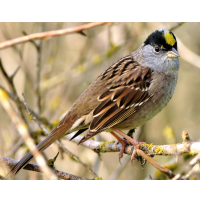A Lot of Bird Species Carry Lyme Disease Bacteria in California
 Golden-crowned sparrow
Golden-crowned sparrow
Around 30,000 cases of Lyme disease are reported each year, mostly back East, but the federal Centers for Disease Control and Prevention (CDC) suspects the actual number could be 10 times that large.
California only records about 100 cases a year, but a recent study published in the journal PLOS ONE indicates there is a possibility that number could grow quickly. Although woodrats, western gray squirrels, deer and other small mammals are generally considered the most likely creatures to host the western black-legged ticks that carry the bacteria responsible for the disease, birds might give them a run for their money.
The dark-eyed junco had previously been identified as a likely source of the bacteria, but researchers found 23 of 53 bird species tested were infected. They looked at 623 birds at 14 sites in Mendocino County and found 284 juvenile ticks on 100 of them. Fifty-seven of those birds had Lyme disease spirochetes.
In addition to the dark-eyed junco, the lesser goldfinch, American robin, oak timouse and especially the golden-crowned sparrow were found to be carriers. These birds are commonly found in suburban areas. The ticks are deposited on vegetation and wait for a potential host to brush against them. Once aboard, the tick burrows into the skin and infects the host with the bacteria.
This is not the first time birds have been implicated in the spreading of Lyme disease. A 2009 study out of Yale University identified 71 species of birds in North America that carry the tick and speculated, “Because of their capacity for long-range movement, birds may play an important role in the spread and range expansion” of the bacteria.
But “this is the most extensive study of the role of birds in Lyme disease ecology in the western United States, and the first to consider the diversity of bird species, their behaviors and their habitats in identifying which birds are truly the most important as carriers,” according to ecologist and lead author Erica Newman.
Lyme disease can cause swollen lymph nodes, muscle and join pain, facial muscle weakness and heart irregularities. It gets worse—arthritis and nervous system problems—if left untreated.
The California Department of Public Health (CDPH) says that the western black-legged tick has been found in 56 of the state’s 58 counties. It is most common in humid coastal areas and along the edge of the Sierra Nevadas. The tick goes through larva, nymph and adult stages. The first two feed on the blood of small rodents, rabbits, lizards and birds.
Ticks at all three stages, apparently, like humans and other mammals.
–Ken Broder
To Learn More:
Study IDs Key Birds That Host Lyme Disease Bacteria in California (by Sarah Yang, University of California, Berkeley)
Common Birds May Be Spreading Lyme Disease in California More Than Known, Study Shows (KCBS)
Many California Bird Species Host Lyme Disease Bacteria, Study Finds (by Louis Sahagun, Los Angeles Times)
Borrelia Burgdorferi Sensu Lato Spirochetes in Wild Birds in Northwestern California (University of California, Berkeley)
- Top Stories
- Controversies
- Where is the Money Going?
- California and the Nation
- Appointments and Resignations
- Unusual News
- Latest News
- California Forbids U.S. Immigration Agents from Pretending to be Police
- California Lawmakers Urged to Strip “Self-Dealing” Tax Board of Its Duties
- Big Oil’s Grip on California
- Santa Cruz Police See Homeland Security Betrayal in Use of Gang Roundup as Cover for Immigration Raid
- Oil Companies Face Deadline to Stop Polluting California Groundwater





